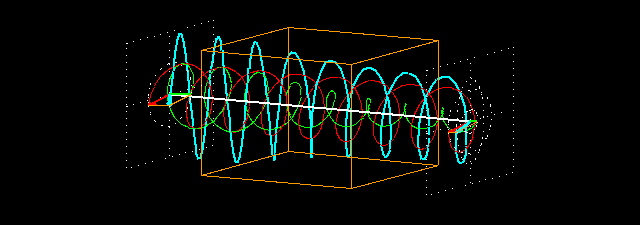
Some materials possess a special property: they absorb left circularly polarized light to a different extent than right circularly polarized light. This phenomenon is called circular dichroism.
Linearly polarized light can be obtained as the superposition of a left circularly polarized and a right circularly polarized light wave. Therefore, if linearly polarized light traverses a medium that shows circular dichroism, its properties will change because the medium absorbs the two circularly polarized components to a different extent.
Animation: what happens when a plane-polarized (vertical, blue) light traverses a medium that does not absorb the left circularly polarized component of the wave at all (red wave) but highly absorbs the right circularly polarized component (green wave).

We placed an intersecting plane before and after the piece of material and we show the field vectors at the point of intersection of the light beam and the intersecting planes. The following animation shows the intersecting planes from the front. On the left, the plane before the material; on the right, the plane after the material.

The component shown in red traverses the medium unchanged and the component shown in green gets fainter: its intensity decreases to about 36% of the original value. The superposition of the two components is no longer a linearly polarized wave: the resulting field vector does not oscillate along a straight line but it rotates along and ellipsoid path. Such a light wave is called an elliptically polarized light.
Take a close look and notice that the big axis of the ellipse is parallel to the polarization plane of the original light wave. This is always the case, regardless of which circular component is absorbed more by the medium. But the direction of rotation of the elliptically polarized light (or, more exactly, its field vector) is determined by the circular component that remains stronger after traversing the material. In our case, the field vector of the elliptically polarized light rotates in the same direction as that of the component shown in red color, which traverses the medium without losing intensity.
Of course, it is very unusual for a material not to absorb one circular component at all. Real materials usually absorb both components, to a different extent. It was only for the sake of simplicity that we presented a situation where the material is completely transparent to one of the circularly polarized components.
How elliptical the plane-polarized wave becomes after traversing the medium is determined by the difference between the absorptions of the two circularly polarized components. In the most extreme case, the material almost completely extincts one component--and then the plane-polarized wave almost becomes a perfect circularly polarized light because the other circular component disappears.
Please note: circular dichroism makes plane-polarized light elliptically polar.
Notice: The word "dichroism" means that the material absorbs two different types of light differently.